It looks like you're using an Ad Blocker.
Please white-list or disable AboveTopSecret.com in your ad-blocking tool.
Thank you.
Some features of ATS will be disabled while you continue to use an ad-blocker.
share:
I have not seen these around so I am posting them to show the shills what quality we SHOULD be getting and what terrible quality is being fed to us.
These are official NASA photos although I cannot remember where I got them from - someone may have sent them to me. The official names of the images
are so you may be able to find them online. The originals are larger as they would not fit into the 500Kb limit of ATS.
PIA15108_fig1.jpg
PIA15108_fig1.jpg
PIA15108_fig1.jpg
PIA15108_fig4.jpg
PIA15106_fig1.jpg
PIA16104_fig1.jpg
PIA16104_fig2.jpg
Firstly the Cameras and then the reference images.
cameras
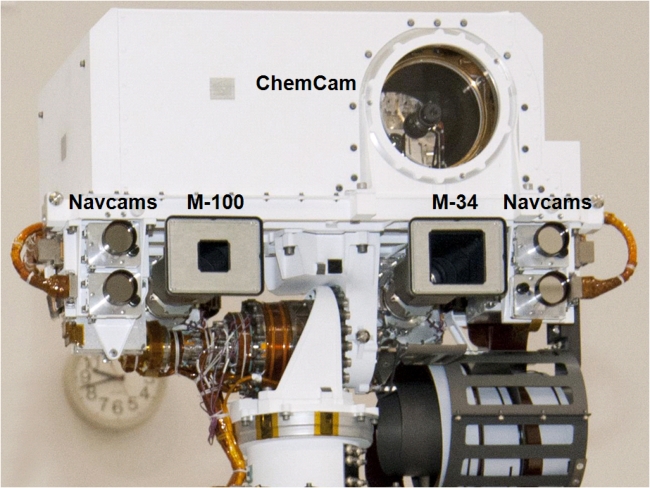
files.abovetopsecret.com...
distance image
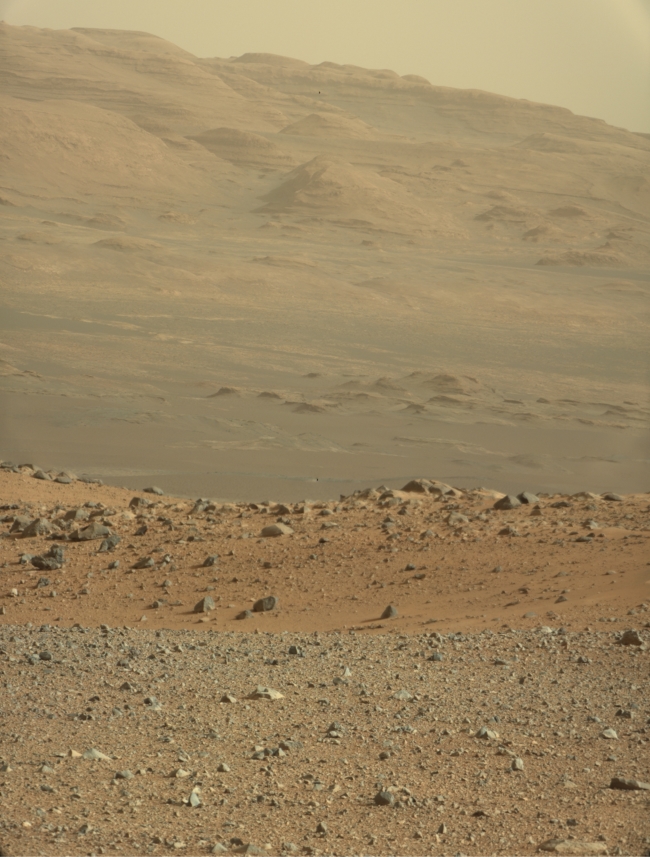
files.abovetopsecret.com...
annotated distances marked

files.abovetopsecret.com...
m34 @ 50m
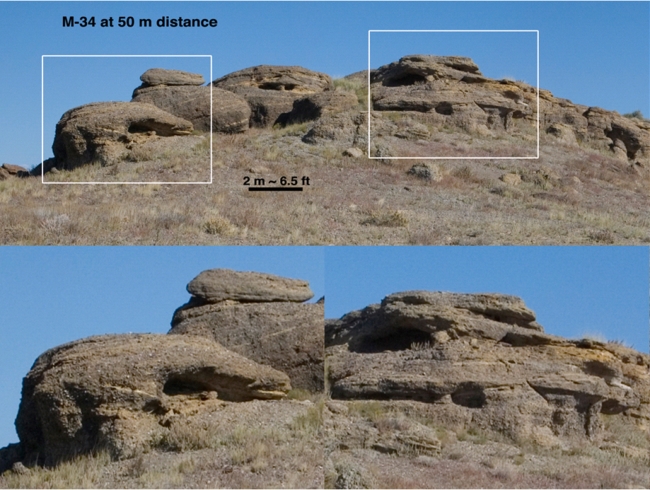
files.abovetopsecret.com...
m100 @ 100m
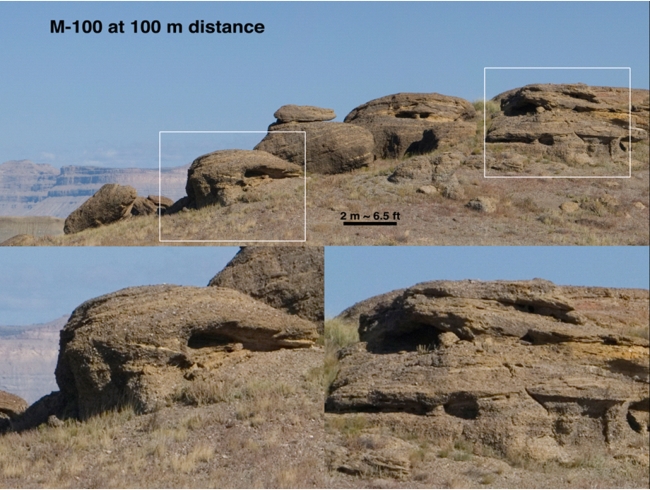
files.abovetopsecret.com...
m100 @ 50m
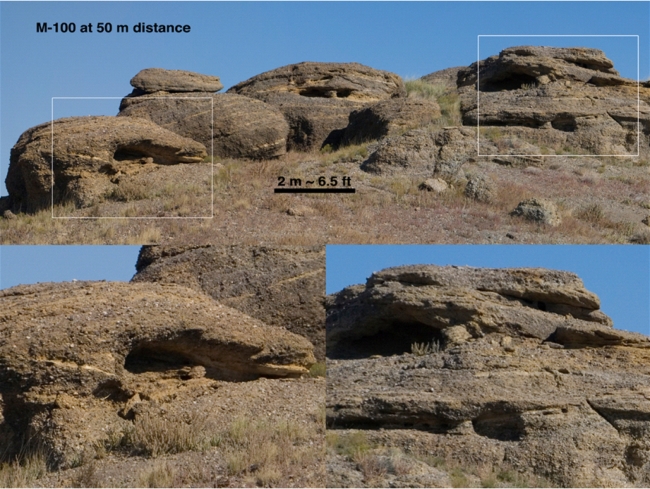
files.abovetopsecret.com...
m34 & m100 @ 10m

files.abovetopsecret.com...
PIA15108_fig1.jpg
PIA15108_fig1.jpg
PIA15108_fig1.jpg
PIA15108_fig4.jpg
PIA15106_fig1.jpg
PIA16104_fig1.jpg
PIA16104_fig2.jpg
Firstly the Cameras and then the reference images.
cameras

files.abovetopsecret.com...
distance image

files.abovetopsecret.com...
annotated distances marked

files.abovetopsecret.com...
m34 @ 50m

files.abovetopsecret.com...
m100 @ 100m

files.abovetopsecret.com...
m100 @ 50m

files.abovetopsecret.com...
m34 & m100 @ 10m

files.abovetopsecret.com...
Originally posted by heathwithnoteeth
are all these photos of mars? or just reference?
They can't all be of mars; I don't remember Mars having a blue sky and plants everywhere. I was going to reply to this thread when it first popped up, but I was too confused about what it was to say anything.
OP, what is this?
There is a lot of dust in the martian atmosphere. It's somewhat like being in a light (but global) dust storm, hence the colour of the sky and the
poor clarity of distant objects.

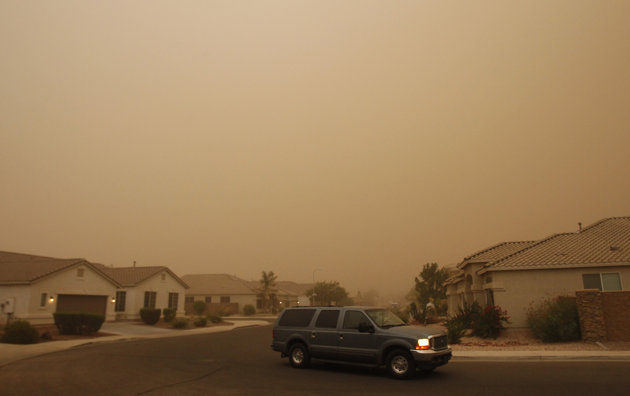
Also consider the fact that the published images have had jpeg compression to reduce the filesize.


Also consider the fact that the published images have had jpeg compression to reduce the filesize.
A couple of things here.
The space exploration forum is historically less of a conspiracy forum, and more of a Learning/Teaching forum.
Unfortunately the opposite is becoming true.
The thread you have started had promise. Decoding some things that aren't common knowledge. Like, how the rover cameras work, what they are for, the knowledge is readily available. but it's always nice to have a "laymans" definition. To help others understand. It would be excellent for you, and others, myself included. to teach what you know, or what you have discovered.
Oh, and to not call your students, Shills..
The space exploration forum is historically less of a conspiracy forum, and more of a Learning/Teaching forum.
Unfortunately the opposite is becoming true.
The thread you have started had promise. Decoding some things that aren't common knowledge. Like, how the rover cameras work, what they are for, the knowledge is readily available. but it's always nice to have a "laymans" definition. To help others understand. It would be excellent for you, and others, myself included. to teach what you know, or what you have discovered.
Oh, and to not call your students, Shills..
There is no conspiracy here in this post. Where is the conspiracy? There is no argument when looking at these images and looking at the Mars images.
That is not a conspiracy it is fact that they are not the same quality even though they are taken with exactly the same camera..
Who said I was calling "students" shills? You are the one who mentions students and I am no teacher of this stuff anyway. All I did was to post a few images which I had, which explained the distance queries some people have in the martian photos. There is another thread which asks what the distances are and I though maybe it would be useful to have the official NASA images explaining this.
Why I have to explain myself I really dont know. Take it or leave it. If you dont like the fact that these have been posted, then just dont comment on them and the thread will die and can serve for a reference if anyone want to use it as such.
The annotated and un-annotated distance images I think are taken on Mars but the others are not. I seem to recognise the Martian landscape, but I am not 100% sure.
I do not think the fact that these are jpg files and have been compressed has anything to do with whether they are accurate of not, does it? I am not knowlegable enough about this to say either way. Maybe you can explain why you think it would have any bearing on the accuracy of distance determination?
Who said I was calling "students" shills? You are the one who mentions students and I am no teacher of this stuff anyway. All I did was to post a few images which I had, which explained the distance queries some people have in the martian photos. There is another thread which asks what the distances are and I though maybe it would be useful to have the official NASA images explaining this.
Why I have to explain myself I really dont know. Take it or leave it. If you dont like the fact that these have been posted, then just dont comment on them and the thread will die and can serve for a reference if anyone want to use it as such.
The annotated and un-annotated distance images I think are taken on Mars but the others are not. I seem to recognise the Martian landscape, but I am not 100% sure.
I do not think the fact that these are jpg files and have been compressed has anything to do with whether they are accurate of not, does it? I am not knowlegable enough about this to say either way. Maybe you can explain why you think it would have any bearing on the accuracy of distance determination?
I dont understand the question. They are official NASA images which give examples of distances in images taken by the same cameras which are on Mars. Dont ask me how to transfer this distance information to the images taken by the cameras on Mars. I have no idea.
OP, what is this?
Well everyone says this but somehow the MER rovers have managed to remain dust free for over 6 years. Why do we not see a dust/dirt build-up around rocks? How come the blueberries are not swept into piles by the wind eh?
There is a lot of dust in the martian atmosphere. It's somewhat like being in a light (but global) dust storm, hence the colour of the sky and the poor clarity of distant objects.
reply to post by qmantoo
Please explain what exactly are you trying to say in your OP. All you did was post the images and say that you posted them "to show the shills what quality we SHOULD be getting and what terrible quality is being fed to us."
Please elaborate how it relates to the images you posted. Do the images from Mars appear to be of lower quality than those from Earth? Or the other way round?
We've known for a long time that the cameras on Curiosity are very humble in comparison to the modern consumer or even phone cameras. So low resolution shouldn't be an issue here. If it's clarity of the distant objects that bothers you, then I already explained that the martian atmosphere is dusty. The dust doesn't just settle and cover everything in a thick layer; it's mostly kept floating in the atmosphere due to winds. What little dust did settle on the rovers might have been swept off by wind as well. On Curiosity, you can see some remaining dust. The layer of dust on the ground is actually very thin.
JPEG compression does play a role in how the final image appears; heavy compression (which I noticed on Curiosity images) reduces the fine detail and introduces compression artifacts.
Please explain what exactly are you trying to say in your OP. All you did was post the images and say that you posted them "to show the shills what quality we SHOULD be getting and what terrible quality is being fed to us."
Please elaborate how it relates to the images you posted. Do the images from Mars appear to be of lower quality than those from Earth? Or the other way round?
We've known for a long time that the cameras on Curiosity are very humble in comparison to the modern consumer or even phone cameras. So low resolution shouldn't be an issue here. If it's clarity of the distant objects that bothers you, then I already explained that the martian atmosphere is dusty. The dust doesn't just settle and cover everything in a thick layer; it's mostly kept floating in the atmosphere due to winds. What little dust did settle on the rovers might have been swept off by wind as well. On Curiosity, you can see some remaining dust. The layer of dust on the ground is actually very thin.
JPEG compression does play a role in how the final image appears; heavy compression (which I noticed on Curiosity images) reduces the fine detail and introduces compression artifacts.
Originally posted by qmantoo
There is a lot of dust in the martian atmosphere. It's somewhat like being in a light (but global) dust storm, hence the colour of the sky and the poor clarity of distant objects.
Well everyone says this but somehow the MER rovers have managed to remain dust free for over 6 years. Why do we not see a dust/dirt build-up around rocks? How come the blueberries are not swept into piles by the wind eh?
Where in the world did you get the idea that the MERs are not being covered with dust?
Opportunity Self Picture, Feb 2012
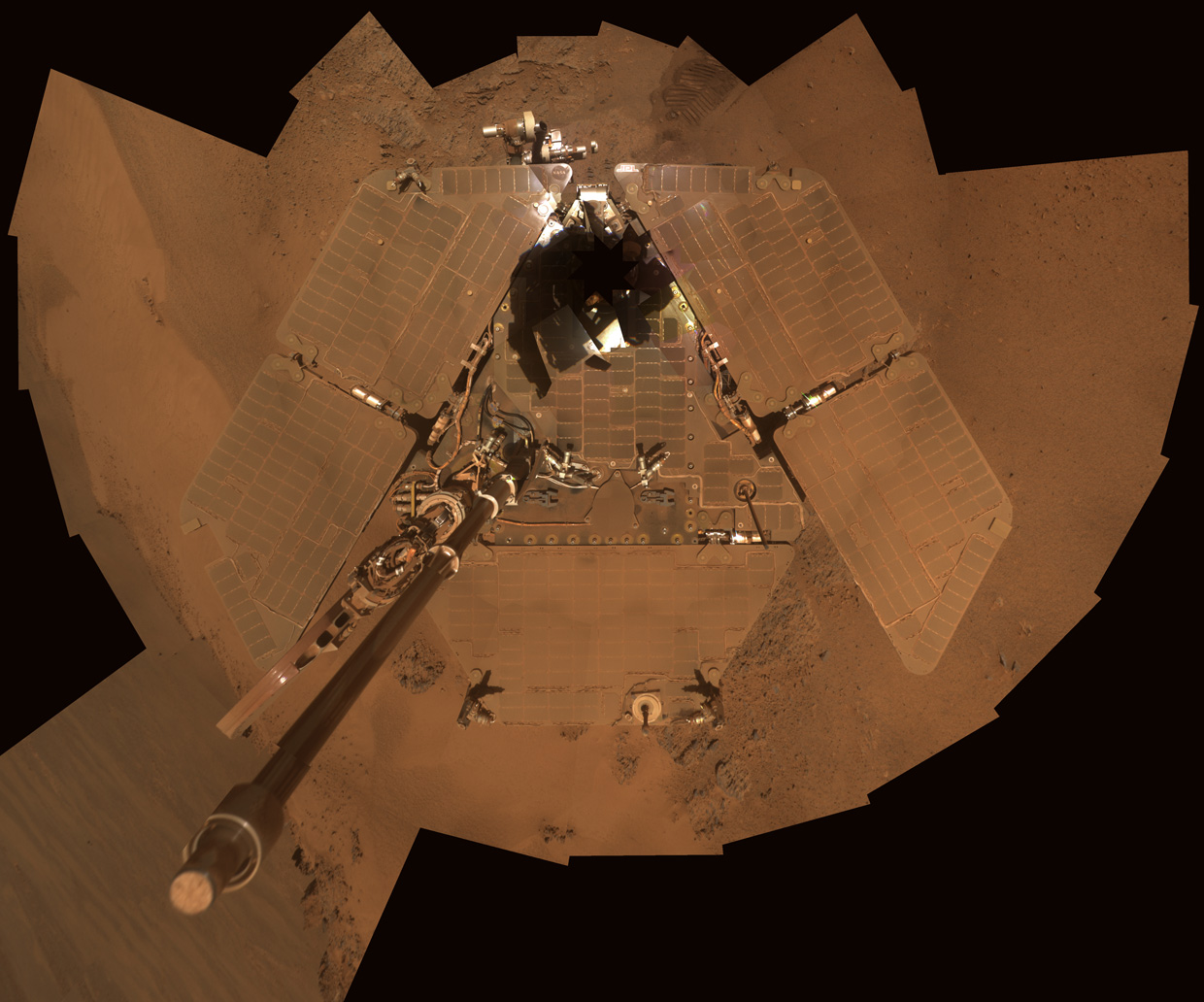
Sprit Self Pic Nov 2008
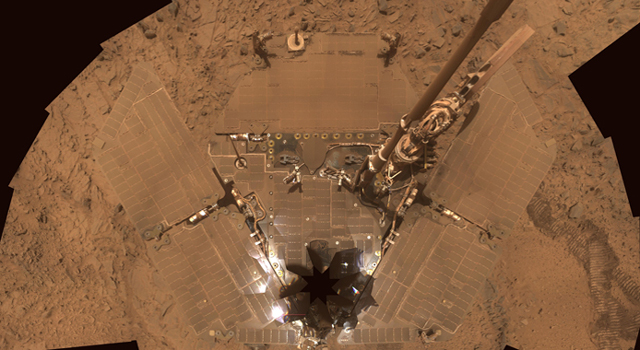
Both Spirit and Opportunity have been through dust storms.
However, even without the storms, martian dust is in the atmosphere, and even Curiosity, which hasn't been through one, is starting to show dust settling on it in places:
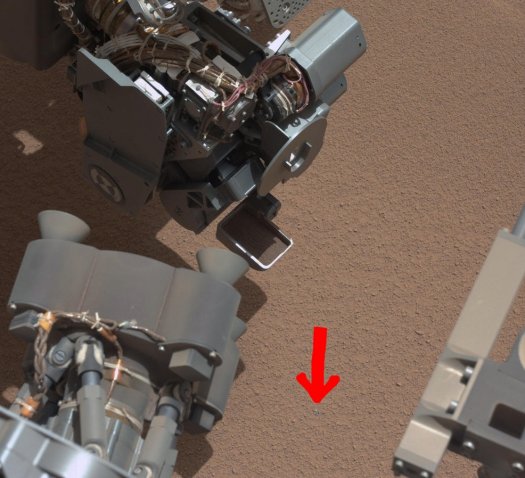
Curiosity Picture Source
What in the world made you think the MERs are not covered with dust?
Well, strangely enough no-one has pointed to evidence of wind blowing blueberries into piles, which after all are only roughly 5-15mm diameter in
size. The wind is supposed to gust at up to 70mph in places but oddly, there is no build-up around either side of rocks. There are thousands of images
from Mars and none with little piles of blueberries where the wind has blown them. A normal wind effect for small light objects is to be blown into
lee areas behind rocks, in dips, etc. like rubbish is here on Earth. What deposits of soil I do see around rocks do not come from high winds blown
over millions of years.
Incidentally, if all this dust is in the wind, where are the piles of dust on rocks? Over millions of years, you would have thought that in some places rocks would be almost buried in this fine dust which gets carried in the wind, yet we see 5mm small blueberries which are still not covered.
I am sorry, some things does not add up and the explanations do not provide answers either.
I liked the surround-images of the rovers with the orange tint. Very arty. The only trouble is that other images show perfectly clean solar panels.
Incidentally, if all this dust is in the wind, where are the piles of dust on rocks? Over millions of years, you would have thought that in some places rocks would be almost buried in this fine dust which gets carried in the wind, yet we see 5mm small blueberries which are still not covered.
I am sorry, some things does not add up and the explanations do not provide answers either.
I liked the surround-images of the rovers with the orange tint. Very arty. The only trouble is that other images show perfectly clean solar panels.
Originally posted by qmantoo
Well, strangely enough no-one has pointed to evidence of wind blowing blueberries into piles, which after all are only roughly 5-15mm diameter in size. The wind is supposed to gust at up to 70mph in places but oddly, there is no build-up around either side of rocks. There are thousands of images from Mars and none with little piles of blueberries where the wind has blown them. A normal wind effect for small light objects is to be blown into lee areas behind rocks, in dips, etc. like rubbish is here on Earth. What deposits of soil I do see around rocks do not come from high winds blown over millions of years.
Incidentally, if all this dust is in the wind, where are the piles of dust on rocks? Over millions of years, you would have thought that in some places rocks would be almost buried in this fine dust which gets carried in the wind, yet we see 5mm small blueberries which are still not covered.
I am sorry, some things does not add up and the explanations do not provide answers either.
I liked the surround-images of the rovers with the orange tint. Very arty. The only trouble is that other images show perfectly clean solar panels.
The atmosphere on Mars is not high enough in pressure to do the things you want, and has not been that way for well over 1 to 2 billion years.
The current air pressure is enough to be able to move the dust (measuring on the micron scale, so much, MUCH smaller than the blue berries).
The dust does move around, and dunes are formed (please take a look at all the MERs and HiRise pictures, you can see dunes of dusts in those pictures).
70 mph is fast....however if the density of what is moving is much less than something else, the effect it has is less.
Here is an analogy of what I'm talking about:
Imagine that there is a steady breeze outside here on Earth, blowing at about 15 mph. Go outside, you'll feel it, it will even move your hair and clothes some, but you can walk around it it just fine. It's not trying to bowl you over or anything like that.
Now go find a river that's deep with a flow of the same speed, 15 mph. Get in it, and try to stand straight or move against that water.
Because water is much denser, it is going to move you a lot easier than the less dense air.
It's the same thing with Mars, the air there is much, much less dense then the air here on Earth. It is strong enough to move dust that measures in the micron size, but is not dense enough to move the blue berries that are much bigger and mass more.
so how did the blueberries pile up?
Originally posted by eriktheawful
Originally posted by qmantoo
Well, strangely enough no-one has pointed to evidence of wind blowing blueberries into piles, which after all are only roughly 5-15mm diameter in size. The wind is supposed to gust at up to 70mph in places but oddly, there is no build-up around either side of rocks. There are thousands of images from Mars and none with little piles of blueberries where the wind has blown them. A normal wind effect for small light objects is to be blown into lee areas behind rocks, in dips, etc. like rubbish is here on Earth. What deposits of soil I do see around rocks do not come from high winds blown over millions of years.
Incidentally, if all this dust is in the wind, where are the piles of dust on rocks? Over millions of years, you would have thought that in some places rocks would be almost buried in this fine dust which gets carried in the wind, yet we see 5mm small blueberries which are still not covered.
I am sorry, some things does not add up and the explanations do not provide answers either.
I liked the surround-images of the rovers with the orange tint. Very arty. The only trouble is that other images show perfectly clean solar panels.
The atmosphere on Mars is not high enough in pressure to do the things you want, and has not been that way for well over 1 to 2 billion years.
The current air pressure is enough to be able to move the dust (measuring on the micron scale, so much, MUCH smaller than the blue berries).
The dust does move around, and dunes are formed (please take a look at all the MERs and HiRise pictures, you can see dunes of dusts in those pictures).
70 mph is fast....however if the density of what is moving is much less than something else, the effect it has is less.
Here is an analogy of what I'm talking about:
Imagine that there is a steady breeze outside here on Earth, blowing at about 15 mph. Go outside, you'll feel it, it will even move your hair and clothes some, but you can walk around it it just fine. It's not trying to bowl you over or anything like that.
Now go find a river that's deep with a flow of the same speed, 15 mph. Get in it, and try to stand straight or move against that water.
Because water is much denser, it is going to move you a lot easier than the less dense air.
It's the same thing with Mars, the air there is much, much less dense then the air here on Earth. It is strong enough to move dust that measures in the micron size, but is not dense enough to move the blue berries that are much bigger and mass more.
OK, well I understand your explanations, although I am not sure that I accept them.
It's the same thing with Mars, the air there is much, much less dense then the air here on Earth. It is strong enough to move dust that measures in the micron size, but is not dense enough to move the blue berries that are much bigger and mass more.
However, it still does not answer the point about the build-up on rocks and behind/in front of rocks over millions of years. In some images there are close-ups of rocks which do not have these dust coverings (after millions of years).
Yet, apparently in only a few short months, Curiosity has a thin film of dust over it and the MERs are supposed to have a millimetre or so. How does that translate to millions of years of thin atmosphere and 70pmh winds?
It seems that there are two opposing solutions being offered and you pick the one which fits the question. There are images of dust devils causing 'tracks' across the landscape which should be enough to move 5mm blueberries surely?
edit on 1 Jun 2013 by qmantoo because: (no reason
given)
so how did the blueberries pile up?
Originally posted by eriktheawful
Originally posted by qmantoo
Well, strangely enough no-one has pointed to evidence of wind blowing blueberries into piles, which after all are only roughly 5-15mm diameter in size. The wind is supposed to gust at up to 70mph in places but oddly, there is no build-up around either side of rocks. There are thousands of images from Mars and none with little piles of blueberries where the wind has blown them. A normal wind effect for small light objects is to be blown into lee areas behind rocks, in dips, etc. like rubbish is here on Earth. What deposits of soil I do see around rocks do not come from high winds blown over millions of years.
Incidentally, if all this dust is in the wind, where are the piles of dust on rocks? Over millions of years, you would have thought that in some places rocks would be almost buried in this fine dust which gets carried in the wind, yet we see 5mm small blueberries which are still not covered.
I am sorry, some things does not add up and the explanations do not provide answers either.
I liked the surround-images of the rovers with the orange tint. Very arty. The only trouble is that other images show perfectly clean solar panels.
The atmosphere on Mars is not high enough in pressure to do the things you want, and has not been that way for well over 1 to 2 billion years.
The current air pressure is enough to be able to move the dust (measuring on the micron scale, so much, MUCH smaller than the blue berries).
The dust does move around, and dunes are formed (please take a look at all the MERs and HiRise pictures, you can see dunes of dusts in those pictures).
70 mph is fast....however if the density of what is moving is much less than something else, the effect it has is less.
Here is an analogy of what I'm talking about:
Imagine that there is a steady breeze outside here on Earth, blowing at about 15 mph. Go outside, you'll feel it, it will even move your hair and clothes some, but you can walk around it it just fine. It's not trying to bowl you over or anything like that.
Now go find a river that's deep with a flow of the same speed, 15 mph. Get in it, and try to stand straight or move against that water.
Because water is much denser, it is going to move you a lot easier than the less dense air.
It's the same thing with Mars, the air there is much, much less dense then the air here on Earth. It is strong enough to move dust that measures in the micron size, but is not dense enough to move the blue berries that are much bigger and mass more.
To the op - so how big is the figure in the bottom left of this image? The famous mars lady is back. mars.jpl.nasa.gov...
edit on 1-6-2013 by symptomoftheuniverse because: added
link,spelling
reply to post by symptomoftheuniverse
I think the "blueberries" pile up, due to the removal of the matrix material in which they are embedded.
As mentioned earlier, the atmosphere is not thick enough to move a blueberry. But there IS enough to erode away the softer material that holds those berries. You could say that it will move a muffin, but not the stuffin. The "muffin" is eroded away one crumb at a time. And there IS a lot of time for these things to happen. The berries eventually pile-up under the now non-existent muffin...
And now I am hungry.
I think the "blueberries" pile up, due to the removal of the matrix material in which they are embedded.
As mentioned earlier, the atmosphere is not thick enough to move a blueberry. But there IS enough to erode away the softer material that holds those berries. You could say that it will move a muffin, but not the stuffin. The "muffin" is eroded away one crumb at a time. And there IS a lot of time for these things to happen. The berries eventually pile-up under the now non-existent muffin...
And now I am hungry.
reply to post by qmantoo
I was simply using analogies to illustrate how the posting style in science threads has become a sort of Hatfields and McCoys when it comes to theories. We don't talk to each other anymore. We preach, and talk AT each other.
Then we start to hold grudges, if someone pops in to give an excellent explanation of the physical processes of things that exist in space.
Your thread idea is a good premise. So Teach us something!
I was simply using analogies to illustrate how the posting style in science threads has become a sort of Hatfields and McCoys when it comes to theories. We don't talk to each other anymore. We preach, and talk AT each other.
Then we start to hold grudges, if someone pops in to give an excellent explanation of the physical processes of things that exist in space.
Your thread idea is a good premise. So Teach us something!
reply to post by spacedoubt
With an atmosphere a hundred times thinner and mars has planetary dust storms? And the cameras can see through our atmosphere better? Is there lots of dust on venus?
With an atmosphere a hundred times thinner and mars has planetary dust storms? And the cameras can see through our atmosphere better? Is there lots of dust on venus?
The blue berries and other rocks no longer have a thick atmosphere to move them around (and here on Earth, it can take very high winds to move rocks
around even though our atmosphere is thicker). However they do have geological processes working on them.
You have water vapor in the air that can condense into frost. Add that frost to a small round object, and it can become unbalanced and roll. The frost then sublimates as it warms up which could also add to that. That same frost can get into cracks, expand and make the cracks bigger.
Tremors or quakes can move things, and millions to billions of years is a long time for things to happen.
In some places there are dust pile ups on rocks, some places there are not. Some places there are dunes, and some places there are not any.
Just like here on Earth. Terrain and environments vary.
Did you expect Mars to be some uniform terrain where everything will be the same?
Mars still has a atmosphere. Thin, but it wasn't always so, and even thin it can have effects on the terrain. In the past, Mars was geologically more active than it is now. In the past, water flowed, eroded soil, rocks, piled things up, removed piles.
Eventually that water has gone away, into what little atmosphere is left, and into the ground. However, while most of the water is not there on the surface, it had a long time to make it's presence known on that surface all over the planet.
Dust is just about everywhere on Mars. It's all over the rocks, it is piled up in some places, and not in others. This is not strange to me as it looks just like many places here on Earth where dust can settle (and Mars dust has the consistancy of flour). While it does coat just about everything, it will not be like a coat of snow covering everything here on Earth, because it's not like snow.
-----------
Dust Storms On Mars: yes. Mars may have a thin atmosphere, but it still has one, and being that there is one, Mars has weather. Winds can pick up and create dust storms, some times so massive it can cover the whole planet.
Here is a article about a large dust storm in the southern hemisphere of Mars back in Nov. 2012:
NASA Tracks Big Dust Storm On Mars
Here is another link with more information on Mars and it's dust storms:
Mars Dust Storms (has excellent pictures of a planetary dust storm in July 2001).
As for dust on Venus: I imagine that being a rocky world, that there is dust (there is even dust on the moon), however as for how it looks for he most part and acts on Venus, there is not too much information there since most probes that have been sent to the surface do not last very long in the crushing pressure and intense heat that is at the surface of Venus. The russian probe Venera 12 lasted the longest at 110 minutes before it was destroyed by those effects.
You have water vapor in the air that can condense into frost. Add that frost to a small round object, and it can become unbalanced and roll. The frost then sublimates as it warms up which could also add to that. That same frost can get into cracks, expand and make the cracks bigger.
Tremors or quakes can move things, and millions to billions of years is a long time for things to happen.
In some places there are dust pile ups on rocks, some places there are not. Some places there are dunes, and some places there are not any.
Just like here on Earth. Terrain and environments vary.
Did you expect Mars to be some uniform terrain where everything will be the same?
Mars still has a atmosphere. Thin, but it wasn't always so, and even thin it can have effects on the terrain. In the past, Mars was geologically more active than it is now. In the past, water flowed, eroded soil, rocks, piled things up, removed piles.
Eventually that water has gone away, into what little atmosphere is left, and into the ground. However, while most of the water is not there on the surface, it had a long time to make it's presence known on that surface all over the planet.
Dust is just about everywhere on Mars. It's all over the rocks, it is piled up in some places, and not in others. This is not strange to me as it looks just like many places here on Earth where dust can settle (and Mars dust has the consistancy of flour). While it does coat just about everything, it will not be like a coat of snow covering everything here on Earth, because it's not like snow.
-----------
Dust Storms On Mars: yes. Mars may have a thin atmosphere, but it still has one, and being that there is one, Mars has weather. Winds can pick up and create dust storms, some times so massive it can cover the whole planet.
Here is a article about a large dust storm in the southern hemisphere of Mars back in Nov. 2012:
NASA Tracks Big Dust Storm On Mars
Here is another link with more information on Mars and it's dust storms:
Mars Dust Storms (has excellent pictures of a planetary dust storm in July 2001).
As for dust on Venus: I imagine that being a rocky world, that there is dust (there is even dust on the moon), however as for how it looks for he most part and acts on Venus, there is not too much information there since most probes that have been sent to the surface do not last very long in the crushing pressure and intense heat that is at the surface of Venus. The russian probe Venera 12 lasted the longest at 110 minutes before it was destroyed by those effects.
Here's an Opportunity image of "blueberries" piled up between dunes:
marsrovers.jpl.nasa.gov...
False-colour: marsrovers.jpl.nasa.gov...
Source: marsrovers.jpl.nasa.gov...
On the topic of martian winds, I read that seasonal winds near the poles can get up to very high speeds, getting strong enough to move sand up the dune.
False-colour: marsrovers.jpl.nasa.gov...
Source: marsrovers.jpl.nasa.gov...
On the topic of martian winds, I read that seasonal winds near the poles can get up to very high speeds, getting strong enough to move sand up the dune.
Yes, they may be piled up but what did the piling? Are you suggesting that wind did that? Why are you giving this as an example of how blueberries are
piled up by the wind? These would not be called 'cobbles' by NASA if they were 'blueberries' I think. Technically, blueberries are small aren't
they?
My point is that NASA have atributed the wind to cleaning off the MER rovers. They have pointed to dust storms with winds up to and over 70mph and shown us images of devils moving across the dry terrain leaving behind a trail of 'swept' ground. There are huge sand dunes in areas of Mars as shown in satellite images.
Yet, you are telling us that the wind is very localised and is strong in some places and not in others. Sounds rather dodgy to me. But, having said that we have images of the MERs with super clean solar panels, but no build-up of tiny blueberries. How come? This thin atmosphere can only explain so much and over millions of years, even a weak puff of wind is going to erode stuff isn't it?
I guess you are trying to argue both sides of the debate. Maybe they send the MERs in to the garage for a clean up and polish? I would still like to see a pile of blueberries (not boulders) behind a rock somewhere though.
My point is that NASA have atributed the wind to cleaning off the MER rovers. They have pointed to dust storms with winds up to and over 70mph and shown us images of devils moving across the dry terrain leaving behind a trail of 'swept' ground. There are huge sand dunes in areas of Mars as shown in satellite images.
Yet, you are telling us that the wind is very localised and is strong in some places and not in others. Sounds rather dodgy to me. But, having said that we have images of the MERs with super clean solar panels, but no build-up of tiny blueberries. How come? This thin atmosphere can only explain so much and over millions of years, even a weak puff of wind is going to erode stuff isn't it?
I guess you are trying to argue both sides of the debate. Maybe they send the MERs in to the garage for a clean up and polish? I would still like to see a pile of blueberries (not boulders) behind a rock somewhere though.
Originally posted by qmantoo
Yes, they may be piled up but what did the piling? Are you suggesting that wind did that? Why are you giving this as an example of how blueberries are piled up by the wind? These would not be called 'cobbles' by NASA if they were 'blueberries' I think. Technically, blueberries are small aren't they?
My point is that NASA have atributed the wind to cleaning off the MER rovers. They have pointed to dust storms with winds up to and over 70mph and shown us images of devils moving across the dry terrain leaving behind a trail of 'swept' ground. There are huge sand dunes in areas of Mars as shown in satellite images.
Yet, you are telling us that the wind is very localised and is strong in some places and not in others. Sounds rather dodgy to me. But, having said that we have images of the MERs with super clean solar panels, but no build-up of tiny blueberries. How come? This thin atmosphere can only explain so much and over millions of years, even a weak puff of wind is going to erode stuff isn't it?
I guess you are trying to argue both sides of the debate. Maybe they send the MERs in to the garage for a clean up and polish? I would still like to see a pile of blueberries (not boulders) behind a rock somewhere though.
Please post the images of the MERs with "super clean" panels, along with the date the pictures were taken.
Should be simple as that to prove your point. A picture of the panels covered with dust, then a later dated picture of them clean. Would be very easy to prove your point.
new topics
-
Pentagon acknowledges secret UFO project, the Kona Blue program | Vargas Reports
Aliens and UFOs: 45 minutes ago -
Boston Dynamics say Farewell to Atlas
Science & Technology: 53 minutes ago -
I hate dreaming
Rant: 1 hours ago -
Is the origin for the Eye of Horus the pineal gland?
Philosophy and Metaphysics: 3 hours ago -
Man sets himself on fire outside Donald Trump trial
Mainstream News: 3 hours ago -
Biden says little kids flip him the bird all the time.
2024 Elections: 3 hours ago -
The Democrats Take Control the House - Look what happened while you were sleeping
US Political Madness: 4 hours ago -
Sheetz facing racial discrimination lawsuit for considering criminal history in hiring
Social Issues and Civil Unrest: 4 hours ago -
In an Historic First, In N Out Burger Permanently Closes a Location
Mainstream News: 6 hours ago -
MH370 Again....
Disaster Conspiracies: 6 hours ago
top topics
-
In an Historic First, In N Out Burger Permanently Closes a Location
Mainstream News: 6 hours ago, 14 flags -
The Democrats Take Control the House - Look what happened while you were sleeping
US Political Madness: 4 hours ago, 10 flags -
Thousands Of Young Ukrainian Men Trying To Flee The Country To Avoid Conscription And The War
Other Current Events: 16 hours ago, 8 flags -
A man of the people
Medical Issues & Conspiracies: 11 hours ago, 8 flags -
Man sets himself on fire outside Donald Trump trial
Mainstream News: 3 hours ago, 7 flags -
Biden says little kids flip him the bird all the time.
2024 Elections: 3 hours ago, 6 flags -
4 plans of US elites to defeat Russia
New World Order: 13 hours ago, 4 flags -
Is the origin for the Eye of Horus the pineal gland?
Philosophy and Metaphysics: 3 hours ago, 4 flags -
Sheetz facing racial discrimination lawsuit for considering criminal history in hiring
Social Issues and Civil Unrest: 4 hours ago, 3 flags -
Are you ready for the return of Jesus Christ? Have you been cleansed by His blood?
Religion, Faith, And Theology: 8 hours ago, 3 flags
active topics
-
The defamation of Mary Magdalene
Religion, Faith, And Theology • 13 • : Solvedit -
12 jurors selected in Trump criminal trial
US Political Madness • 105 • : ImagoDei -
The Democrats Take Control the House - Look what happened while you were sleeping
US Political Madness • 35 • : ImagoDei -
Russian intelligence officer: explosions at defense factories in the USA and Wales may be sabotage
Weaponry • 176 • : BernnieJGato -
-@TH3WH17ERABB17- -Q- ---TIME TO SHOW THE WORLD--- -Part- --44--
Dissecting Disinformation • 543 • : SideEyeEverything1 -
Elites disapearing
Political Conspiracies • 33 • : 0bserver1 -
Man sets himself on fire outside Donald Trump trial
Mainstream News • 29 • : ByeByeAmericanPie -
Fossils in Greece Suggest Human Ancestors Evolved in Europe, Not Africa
Origins and Creationism • 78 • : strongfp -
Pentagon acknowledges secret UFO project, the Kona Blue program | Vargas Reports
Aliens and UFOs • 2 • : Macenroe1982 -
In an Historic First, In N Out Burger Permanently Closes a Location
Mainstream News • 8 • : KrustyKrab
